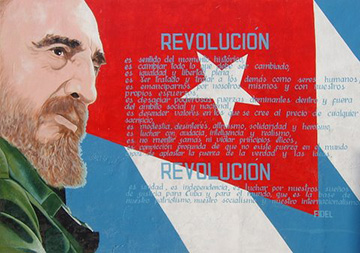
On September 3 as drizzle gave way to early morning sun, ex- President Fidel Castro, “Commander of the Cuban Revolution,” discussed the threat of worldwide war. His mostly student audience heard him speaking from the top of stairs leading to the University of Havana where Castro himself enrolled 65 years ago on September 4, 1945.
Castro had not spoken publically for four years, except for remarks August 7 before the National Assembly. Receiving the occasional visitor, Castro remained in seclusion following his illness and leaving the presidency in July 2006. From March 28, 2007 on, however, he has written 346 “Reflections of Fidel.” for Cuba’s press and for worldwide Internet dissemination. Two months ago he began reappearing in public.
This time, Castro, dressed in olive green military attire, marshaled evidence pointing to imminent threat to human survival. Prensa Latina reported on his “unleashing the battle for life, against war and for peace, against imperial designs and for ideals of generosity and solidarity and above all, for protecting humankind from a nuclear catastrophe with unforeseen consequences.”
Elaborating on a theme he’s pursued in writing over three months, Castro warned of conflict between Iran, intent upon developing nuclear power capabilities, and nations headed by the United States that on June 9 induced the UN Security Council to pass a resolution requiring Iran to curtail uranium enrichment and reprocessing. Sanctions would take effect once the UN’s International Atomic Energy Agency signals Iranian noncompliance, on September 9 or later. Castro predicted searches of ships carrying banned materials would provoke Iran into blocking the Strait of Hormuz thereby choking off 45 percent of the world’s oil supply. Israeli bombing raids against Iranian nuclear facilities might follow.
“Iranian capabilities of conventional [military] response would provoke a ferocious war, Castro asserted, “whose control would escape from the hands of the warring parties, a situation that would turn inexorably into a global nuclear conflict.” The time is short, he warned: “I am forced, modestly, to reveal to an unsuspecting world the terrible dangers that threaten human life on our planet.”
Castro quoted from technical experts, news reports, government communiqués, and a “citizen of Our America” commenting on the CubaDebate web site. The latter observed: “We need to live in peace and security on a planet that each day becomes less habitable…Nuclear arms must disappear, no country ought to possess them, atomic energy must be used for what is good. The only true victory is in winning peace.”
The electronic correspondent cited the twin challenges of world peace – “no violence against any human being, country or nation” – and of climate change; “We can not turn our back on nature.” Kyoto signifies hope, he wrote.
Castro quoted, “We must eliminate all that which makes man [and women] see the other as his or her enemy. Without any possibility of error I say peace will be achieved with peace, and if you want peace, prepare to change your consciousness.”
Castro himself concluded that, “This reality is deliberately hidden from the world and the hard task of warning humankind of real danger falls upon Cuba.” He confessed to amazement that “a tiny country like Cuba sees itself obliged to carry the weight of struggle against those that have globalized and subjected the world to inconceivable plunder and has imposed a system that today threatens the very survival of humankind.”
Earlier Castro had recounted Spanish soldiers’ slaughter of university students on the steps from which he spoke. He recalled colonizers’ “brute force” manifested during the independence wars and lamented U. S. “plundering of our people.” We are here today, he explained, because “the revolution put an end to these horrors.”
He praised today’s students as “incomparably more cultured, freer, and more conscious” than his own student contemporaries. He commended “the moral support you are offering in this struggle for peace” “Victory is possible!” he declared. Afterwards, students speaking to a reporter welcomed inclusion in the struggle, admired his passion, and were gratified at his speaking to them.
The episode elicited recall by the present writer of picking up a New York Times in 1957 reverberating with the headline, “Castro is still alive and still fighting in the mountains.” Reporter Herbert Matthews had trekked into the Sierra Maestra mountains, interviewed Castro (advertised as dead by the Batista dictatorship), and fashioned a three-part series on an insurgency capturing the imagination of young people all over. His story began with words fit for recycling: “Fidel Castro, the rebel leader of Cuba’s youth, is alive and fighting hard…”
Photo: http://www.flickr.com/photos/peamasher/383511007/sizes/o/










